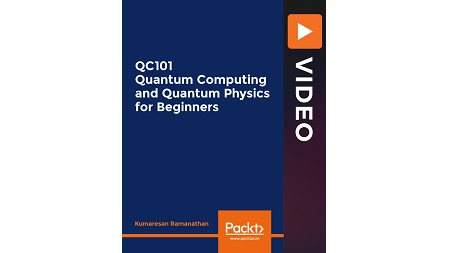
English | MP4 | AVC 1280×720 | AAC 44KHz 2ch | 3h 34m | 2.49 GB
Master quantum computing, quantum cryptography, and quantum physics with Microsoft Q# (Q Sharp) and IBM Quantum Experience.
Quantum computing is the next trend in the software industry. Quantum computers are exponentially faster than today’s classical computers. Problems that were considered too difficult for computers to solve—such as simulations of protein folding in biological systems and cracking RSA encryption—are now possible through quantum computers. How fast are Quantum computers? A 64-bit quantum computer can process 36 billion bytes of information in each step of the computation. Compare that to the 8 bytes that your home computer can process in each computational step!
Companies such as Google, Intel, IBM, and Microsoft are investing billions in their quest to build quantum computers. If you master quantum computing now, you will be ready to profit from this technology revolution. This course teaches quantum computing from the ground up. The only background you need is 12th grade-level high-school Math and Physics. If it has been a while since you completed your high-school Math courses, and if you want a quick review, look at the prerequisite course: QC051: Math Foundation for Quantum Computing.
IMPORTANT: You must enjoy Physics and Math to get the most out of this course. This course is primarily about analyzing the behavior of quantum circuits using Math and Quantum Physics. While everything you need to know beyond 12th-grade high school science is explained here, you must be aware that quantum physics is an extremely difficult subject. You might frequently need to stop the video and replay the lesson to understand it.
In the first part of this course, you will learn to communicate securely using quantum cryptography. Next, you will learn basic quantum physics along with the mathematical tools you need to analyze quantum systems. Finally, you will use industry tools (Microsoft Q# on Visual Studio and IBM Quantum Experience) to develop quantum software. Additionally, the course materials include a downloadable Q# framework that you can use to experiment with quantum algorithms, entanglement, and superposition. Enroll today and join the quantum revolution!
Learn
- Quantum physics and quantum computing concepts are explained, starting from high-school-level (12th grade) Math and Science.
- Introduction to Microsoft Q#
- Introduction to IBM Quantum Experience
Table of Contents
Introduction
1 Introduction
2 How is Quantum Computing Different
Quantum Cryptography
3 Photons
4 Photon Polarization
5 Experiments with Photon Polarization
6 No-Cloning Theorem
7 Encoding with XOR
8 Encryption with Single-Use Shared-Secrets
9 Encoding Data in Photon Polarization
10 Making the Protocol Secure
11 Exchanging Polarization Angles
12 Why is the BB84 protocol secure
13 Analysis
Foundation – Complex Numbers, Probability, Linear Algebra & Logic
14 Probability
15 Complex Numbers 1
16 Complex Numbers 2
17 Complex Numbers 3
18 Matrix Algebra (Linear Algebra)
19 Matrix Multiplication 1
20 Matrix Multiplication 2
21 Identity Matrices
22 Column Matrices
23 x1 Matrices
24 Logic Circuits
Developing a Math Model for Quantum Physics
25 Modeling Physics with Math
26 Subtractive Probabilities Through Complex Numbers
27 Modeling Superposition Through Matrices
28 Overview of Math Model
Quantum Physics of Spin States
29 Introduction to Spin States
30 Basis
31 Column Matrix Representation of Quantum State
32 State Vector
33 Experiments with Spin 1
34 Experiments with Spin 2
35 Experiments with Spin 3
Modeling Quantum Spin States with Math
36 Analysis of Experiments 1
37 Analysis of Experiments 2
38 Analysis of Experiments 3
39 Dirac Bra-Ket Notation 1
40 Dirac Bra-Ket Notation 2
41 More Experiment Analysis 1
42 More Experiment Analysis 2
43 On Random Behaviour
Reversible and Irreversible State Transformations
44 Irreversible Transformations – Measurement
45 Reversible State Transformations
Multi-Qubit Systems
46 Analysing Multi-Qubit Systems
Entanglement
47 Entanglement
Quantum Computing Model
48 Quantum Circuits
49 Fanout
50 Uncomputing
51 Reversible Gates
52 Quantum NOT
53 Other Single Qubit Gates
54 CNOT Gate
55 CCNOT – Toffoli Gate
56 Universal Gate
57 Fredkin Gate
58 Effects of Superposition and Entanglement on Quantum Gates
Quantum Programming with Microsoft Q#
59 Installing Q#
60 Q# simulator hardware architecture
61 Q# Controller
62 Q# Execution Model
63 Measuring Superposition States
64 Iterative Measurements
65 Overview of the 4-Qubit Simulation Framework
66 Iterative Measurement in Q#
67 Set Operation
68 QB4Run Operation
69 Interpreting the Output
70 Output after Initialization
71 NOT Operation
72 Superposition
73 SWAP
74 CNOT
75 Significance of Superposition and Entanglement
76 Effect of Superposition on Quantum Gates
77 Toffoli Gate – General Configuration
78 Toffoli Configured as NOT
79 Toffoli Configured as AND
80 Toffoli Configured as Fanout
IBM Quantum Experience
81 IBM Quantum Experience
Conclusion
82 Speedup Revisited
83 Conclusion
Appendix A
84 Quantum Physics Through Photon Polarization 1
85 Quantum Physics Through Photon Polarization 1
86 Quantum Physics Through Photon Polarization 1
87 Quantum Physics Through Photon Polarization 1
88 Quantum Physics Through Photon Polarization 1
89 Quantum Physics Through Photon Polarization 1
90 Quantum Physics Through Photon Polarization 1
91 Quantum Physics Through Photon Polarization 1
92 Quantum Physics Through Photon Polarization 1
93 Quantum Physics Through Photon Polarization 1
94 Quantum Physics Through Photon Polarization 1
95 Quantum Physics Through Photon Polarization 1
96 Quantum Physics Through Photon Polarization 1
97 Quantum Physics Through Photon Polarization 1
Resolve the captcha to access the links!